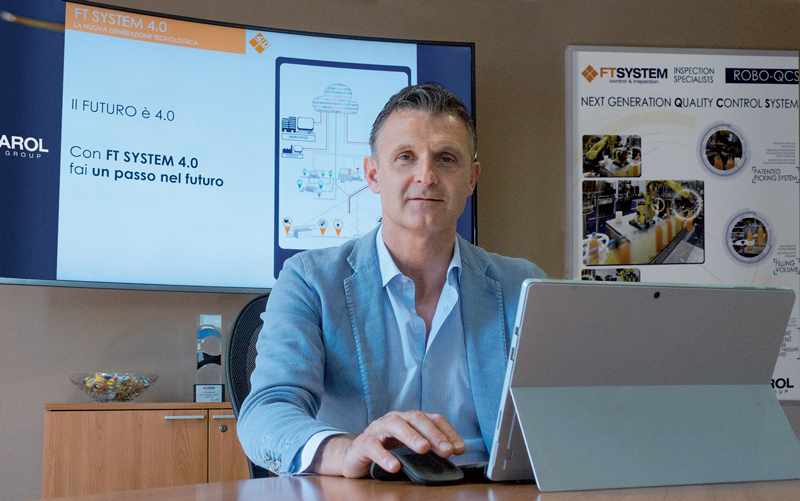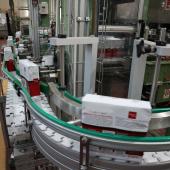FT System in the Cosmopack SMART Area
The functions of Industry 4.0, within FT System, and of the Arol group of which the company is a part, have been implemented following two main directions: the first is to integrate the inspection and control systems with the other machines in the line to optimize their operation; the second is aimed at monitoring the functioning of individual machines to retrieve information for predictive maintenance and remote assistance service. The word to Fabio Forestelli, Ceo di FT System.
Inspection and control systems. In this context, the introduction of "Smart" technologies has led to a paradigm shift. The 4.0 inspection and control systems installed on the lines are not limited to checking the correctness of the filling, closing, labeling and the packaging quality, but are integrated with the "upstream" machines, acquiring a series of additional information to optimize the entire process.
Specifically, as far as the Arol group is concerned, this principle is applied to the closure and capping lines, where controls carried out by the camera systems on the positioning and application of the cap or by systems that detect the tightening force of the cap do not only serve to detect defects, but also to elaborate a series of statistical analyses - such as standard deviation, average closing value, etc. - which allow the operation of the single capping head to be optimized and balanced in real time, automatically correcting any "misalignments".

Predictive maintenance. Everything goes from the sensors mounted on the machines and that allows to monitor the functioning. The data is collected, recorded and processed to identify any anomalies and to produce statistical analysis in real time; all this information is then published in a cloud so as to be able to offer customers a predictive maintenance service and remote assistance.
There is data and data. An aspect that undoubtedly must be taken into consideration and carefully managed, is that of data sharing between the technology provider and the user: in fact it is necessary to distinguish between qualitative and quantitative information relating to production, which the customer hardly wishes to share with third parties, and information from sensors installed on machines that are indicative of their operation - cycles, wear conditions, critical indicators. Data of this type, useful exclusively for identifying any drifts or anomalies in real time, for planning preventive maintenance operations and, in general, for keeping the lines in the most efficient way, does not raise particular confidentiality problems, and can be shared without problems with the machine manufacturer.
In actual fact. In practice, today data sharing takes place, more than anything else, in a specific manner, following a request for remote assistance from the customer. If until a few years ago to check the status of a machine it was necessary to go to the site, today the audit and assistance procedures can be carried out by connecting remotely and checking a series of indicators. Problem resolution is therefore faster, more efficient and at a lower cost than when it was necessary to mobilize technicians and operators.
However, this is a new approach, from the technological and "cultural" point of view, whose potential is not yet fully understood and exploited.
Our goal for the future is to extend the 4.0 maintenance functions by creating an infrastructure that works in a systematic and predictive way.

The most critical aspects to be addressed. A first focus concerns the creation of adequate infrastructures to support a huge amount of information. But it is equally important to focus on the next phase, namely the creation of analysis algorithms able to extrapolate really useful information for customers from the data collected.
Of course, to date, there are several platforms operating in this direction, as well as specialized start-ups in the field of Big Data.
The most important thing, in our opinion, is not to lose sight of the final objective, which is to exploit 4.0 technologies to offer tangible benefits.
to users. Otherwise there is the risk of creating complex and expensive infrastructures capable of storing an impressive amount of data, which the customer is not able, however, to use.
Watchword... customization. To really offer added value, it is therefore essential to understand in detail the specificity of each production, working in close collaboration with the customer to identify which indicators are actually useful to monitor.
Speaking, for example, of quality control systems, it is necessary to study the customer's core business in depth, but also the profile of its consumer type: in other words, defining what is perceived quality, what food quality and safety standards are to be guranteed...
In order to create a "sustainable" data infrastructure, it is necessary to accurately select the useful information to be archived.
Above all, security. It is a vast and crucial topic, which is articulated along two fundamental lines. On the one hand, it is necessary to "physically" guarantee the security and integrity of the data, protecting them from any hacking attempts.
But there is also a second aspect, equally important, which concerns how to protect the ownership and confidentiality of such information, not only from the technological point of view, but also from a legal and judicial standpoint.
In short, even in the technological field, let us not forget that the human factor is still the protagonist.



















